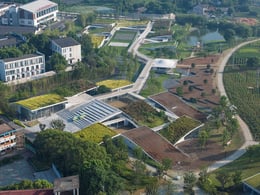Login
Registered users

The project's concept is to create a vibrant space serving the local community and attracting urban residents to rural areas, bridging the urban-rural divide, and promoting rural modernization in China. It emphasizes an open, inclusive, and innovative environment for cultural exchange, industrial development, and social interaction. The design harmonizes with rural geography and culture, providing a shared platform for urban and rural residents. Functional spaces like public services, co-working spaces, creative labs, libraries, and cafes are flexibly distributed and connected by corridors. This enhances efficiency, interaction, and cooperation, aiming to connect urban and rural areas and advance rural revitalization.
The ACDC embodies a dynamic relationship with the undulating terrain. The architectural design seamlessly integrates with the surroundings, utilizing a grid layout that aligns with urban aesthetics and conforms to the natural topography. The rooftop, adorned with vegetation, reshapes the rural landscape, complementing the winding tea fields to form a new scenery. Additionally, the traditional courtyard layout interconnects internal spaces with the terrain, allowing free movement regardless of the building's status, blending public areas with rural activities for sustainable rural development.
Sustainability and ecological compatibility were fully considered in this project, and a variety of strategies, materials, and technologies were used to achieve these goals. These include strategies such as passively design, use of natural lighting and ventilation, rainwater harvesting systems, and energy efficient HVAC systems. Materials were selected using recycled and local materials, low volatile paints, and renewable resources. In addition, the project further enhances sustainability with the use of innovative technologies such as green roofs, solar panels and grey water recycling systems.
Anjihood has developed a tea tourism complex, to modernize China's countryside through design and creativity via the Anji Creative & Design Center (ACDC). This shared space serves the local community and attracts urban visitors, creating a public area that connects city and countryside. ACDC functions as both a public cultural service and a creative design industry infrastructure, highlighting the project's uniqueness. A key strength is its multi-functional design. The members' area, over 4,000 square meters, adapts to changing creative activities. With the rise of digital nomads and remote work, it provides a dynamic space for creatives to collaborate. Other areas showcase creativity and offer shared public services, emphasizing flexibility. ACDC also fosters cultural exchange and community engagement by integrating public services, co-working spaces, creative labs, libraries, and cafes. This enhances local quality of life and attracts urbanites, promoting a symbiotic urban-rural relationship. Sustainability is prioritized with green technology materials, earning award recognition.
In short, ACDC is a catalyst for social, economic, and cultural transformation in rural China. Its adaptability, community focus, and sustainability commitment make it a pioneering model for rural development nationwide.
It becomes a new type of rural space for digital nomads, craftsmen and artists, and a leisure space for the local. Since its completion, it has held various activities including markets, art exhibitions, etc., attracting many tourists, while boosting the community vitality.






















Founded in 2001, Atelier Deshaus, a Shanghai-based studio, began by working mainly on public buildings such as kindergartens, schools and museums, attracting international recognition and winning numerous awards. Its co-founders and principal architects now are Liu Yichun and Chen Yifeng.
Listed in the ‘2011 Design Vanguard’ by Architectural Record, Atelier Deshaus achieved acclaim for the Long Museum, winning the Architectural Review’s Award for Emerging Architecture and the Honor Award Best in Show for Architecture 2019 from AIA’s China Chapter, among others. It participated in exhibitions like ‘Alors, La Chine?’ at Centre Pompidou in 2003 and ‘Reuse, Renew, Recycle’ at MoMA in 2022. Solo exhibitions include “Sensitive Urbanity: Atelier Deshaus in Shanghai” at the RIBA London Headquarters in 2022 and “Common Landscape: Re-cultivating Industrial Sites” at the Aedes Architecture Forum in Berlin 2023.